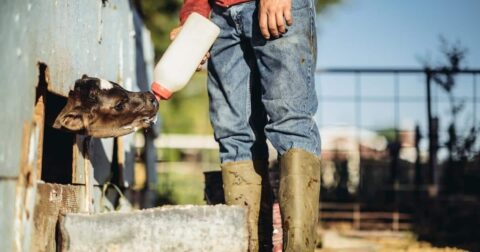Explainer
Trump & RFK’s ‘Make America Healthy Again’ Slogan, Examined
Election 2024•9 min read
Reported
An EU ban on the routine use of antibiotics that could change the face of intensive farming comes into force this month. Will producers comply?


Words by Sophie Kevany
A European Union (EU) ban on the routine use of antibiotics that could change the face of intensive farming comes into force this month. But, like many other EU livestock regulations, critics fear the new law will be flouted.
Intensive farming relies on antibiotics, also known as antimicrobials, to prevent animals from getting sick in disease-friendly farm conditions that often include crowding, stress, poor ventilation, and limited access to fresh air and sunlight.
Early weaning, or the removal of animals from their mothers before they are naturally ready to eat solid food, is another key doorway for disease. Early weaning is used either to decrease the time between pregnancies or as part of the process that redirects milk from offspring to humans. One paper found the pig industry to be especially reliant on antibiotics “during the weaning period when pigs face several challenges and stressors including changes in diet, separation from the sow and re-mixing.”
The new regulation, due to come into effect January 28, states that both prophylactic and metaphylactic antibiotic use should be avoided and says antimicrobials, “shall not be used for prophylaxis other than in exceptional cases.”
In its most basic form, prophylaxis refers to the use of antibiotics to prevent disease before animals get sick, and metaphylaxis involves treating groups of animals where a few might already be sick.
If the ban were properly enforced it would “effectively end cheap animal protein and intensive animal farming,” said Peter Stevenson, a lawyer with NGO, Compassion in World Farming. But, he said, “given the huge business interests involved in both the livestock and pharma sector” there is every reason to think enforcement will fail.
In January, Stevenson told Sentient Media that the “livestock sector appears to have no plans” to end any of the practices most reliant on antibiotics, including early weaning and intensive veal production. Stevenson further pointed to the human risks of a failed ban, most notably exposure to superbugs resistant to antibiotics.
“If the law is flouted, antimicrobial resistance is likely to rise,” said Stevenson. The “EU has an ignominious record of failing to enforce legislation on farm animals—the laws on animal transport and the ban on the routine tail docking of pigs are widely ignored,” he said.
Others gave the ban a cautious welcome, tempered by the same fears of enforcement failure. “The new EU regulation is a positive development,” and the first of its kind globally, said Environmental, Social and Governance (ESG) analyst, Philippa Thornton.
Thornton works with the FAIRR Initiative, a trillion-dollar investor network focused on food sector risks. She added that while the ban was “necessary if we are to address the overuse and misuse of antibiotics in animal agriculture and curb the growing ‘silent pandemic’ of antimicrobial resistance,” she expected its “implementation will be far harder and take longer at the country level as many farmers are not ready to make the changes needed to cut prophylactic use of antibiotics.”
A commission official, asked about the risk that the ban will be disregarded, said although enforcement is the responsibility of individual EU governments, the regulation allows the Commission to audit countries “to verify the functioning of national control systems.” In other words: they will be checking, particularly on the “sales and use” of antibiotics “to evaluate the trends and achievements” of the ban.
Non-compliance, the official added, could mean penalties for “health professionals or farmers” although penalties, and their enforcement, again remain at the discretion of national governments. The official further reminded all concerned that EU countries have had “three years to prepare” for the new rules.
When asked about the ban and its likelihood of failure, a spokesperson for the livestock producer representative, Copa-Cogeca, said that NGOs such as CIWF may be “misinterpreting the sense of the regulation.” Rather than an outright ban, the spokesperson said the new regulation sought to “ensure a better and more responsible use of antibiotics with the aim of combating antimicrobial resistance.”
The comment appears to lean on regulation’s use of the word ‘avoidance’, rather than ‘ban’, and the allowances made for “exceptional cases.” Similar wording has allowed routine piglet tail removal to continue throughout the EU, despite what is seen as a regulatory ban.
Both Copa-Cogeca and Animal Health Europe, an animal pharmaceutical representative organization, said they supported using antibiotics “as little as possible, as much as necessary” and stressed the importance of disease prevention using vaccines, good housing, appropriate feed, veterinary health checks, and biosecurity measures.
The last item on the list is a red flag for critics who see references to biosecurity as a means of supporting more indoor farming. In Romania, for example – a country known for its intensive pig farms that in recent years suffered widespread outbreaks of African Swine Fever (ASF)—a biosecurity debate is expected to play out this year as the government attempts to introduce new regulations that, one critic argues, could favor intensive pig farms.
“The government blamed backyard pig farmers for the ASF outbreak because their pigs are outdoors and might be in contact with wild animals. They see that as less biosecure,” said Attila Szocs-Boruss, president of Eco Ruralis, an organization that represents Romania’s small farmers.
“Even when a scientific paper argued ASF might be more easily spread from the larger farms via mosquitos, the government didn’t seem to take any notice,” he said.
“Now the government is in the process of introducing a new law that will prevent backyard pig farmers from breeding and force them to buy piglets from factory farms,” he said.
The same law caps backyard pig herds at five pigs. “It’s great news for the intensive farms and probably the end of backyard pig herds, all in the name of biosecurity,” he said.
The Romanian government did not immediately respond to a request for comment on the new law, while Copa-Cogeca denied links between biosecurity and intensive farming. Rather, it said, biosecurity, hygiene, and vaccination are all “tools for disease prevention.”
Update: In a letter responding to criticisms of its proposed new law, received 10 February, the Romanian National Sanitary Veterinary and Food Safety Authority told Sentient Media: “This draft law [Bp388/2021; L435/2021] does not prohibit and does not limit the breeding of pigs in backyards from Romania.” Local NGO EcoRuralis pushed back on the claim saying the draft law, as adopted by the senate, clearly mentions [Part 2, Article 4a and 4b, p.5] limiting the number of pigs for small unregistered breeders to five, and prohibits breeding possibilities.